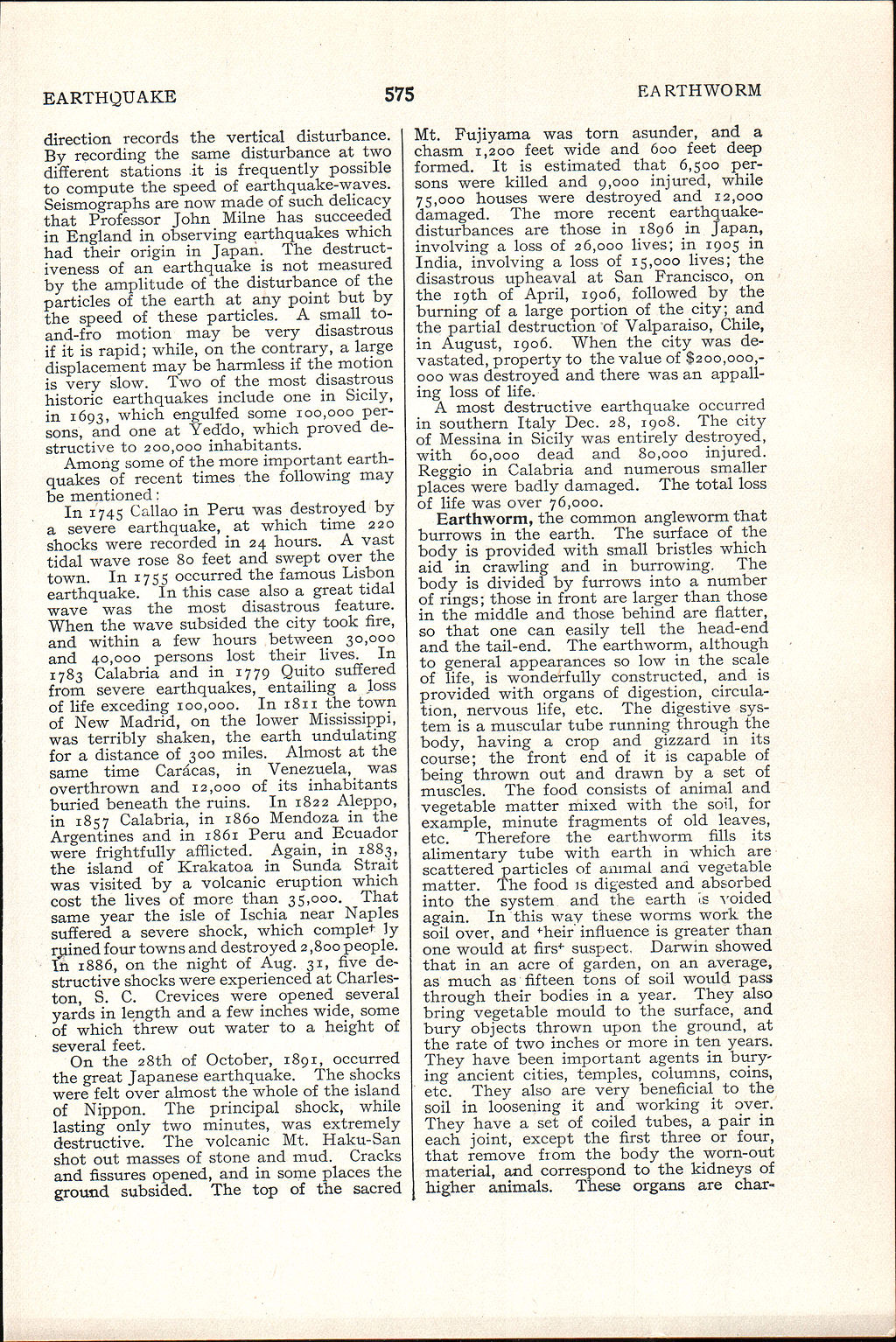direction records the vertical disturbance. By recording the same disturbance at two different stations it is frequently possible to compute the speed of earthquake-waves. Seismographs are now made of such delicacy that Professor John Milne has succeeded in England in observing earthquakes which had their origin in Japan. The destructiveness of an earthquake is not measured by the amplitude of the disturbance of the particles of the earth at any point but by the speed of these particles. A small to-and-fro motion may be very disastrous if it is rapid; while, on the contrary, a large displacement may be harmless if the motion is very slow. Two of the most disastrous historic earthquakes include one in Sicily, in 1693, which engulfed some 100,000 persons, and one at Yeddo, which proved destructive to 200,000 inhabitants.
Among some of the more important earthquakes of recent times the following may be mentioned:
In 1745 Callao in Peru was destroyed by a severe earthquake, at which time 220 shocks were recorded in 24 hours. A vast tidal wave rose 80 feet and swept over the town. In 1755 occurred the famous Lisbon earthquake. In this case also a great tidal wave was the most disastrous feature. When the wave subsided the city took fire, and within a few hours between 30,000 and 40,000 persons lost their lives. In 1783 Calabria and in 1779 Quito suffered from severe earthquakes, entailing a loss of life exceding 100,000. In 1811 the town of New Madrid, on the lower Mississippi, was terribly shaken, the earth undulating for a distance of 300 miles. Almost at the same time Carácas, in Venezuela, was overthrown and 12,000 of its inhabitants buried beneath the ruins. In 1822 Aleppo, in 1857 Calabria, in 1860 Mendoza in the Argentines and in 1861 Peru and Ecuador were frightfully afflicted. Again, in 1883, the island of Krakatoa in Sunda Strait was visited by a volcanic eruption which cost the lives of more than 35,000. That same year the isle of Ischia near Naples suffered a severe shock, which complete1y ruined four towns and destroyed 2,800 people. In 1886, on the night of Aug. 31, five destructive shocks were experienced at Charleston, S. C. Crevices were opened several yards in length and a few inches wide, some of which threw out water to a height of several feet.
On the 28th of October, 1891, occurred the great Japanese earthquake. The shocks were felt over almost the whole of the island of Nippon. The principal shock, while lasting only two minutes, was extremely destructive. The volcanic Mt. Haku-San shot out masses of stone and mud. Cracks and fissures opened, and in some places the ground subsided. The top of the sacred Mt. Fujiyama was torn asunder, and a chasm 1,200 feet wide and 600 feet deep formed. It is estimated that 6,500 persons were killed and 9,000 injured, while 75,000 houses were destroyed and 12,000 damaged. The more recent earthquake-disturbances are those in 1896 in Japan, involving a loss of 26,000 lives; in 1905 in India, involving a loss of 15,000 lives; the disastrous upheaval at San Francisco, on the 19th of April, 1906, followed by the burning of a large portion of the city; and the partial destruction of Valparaiso, Chile, in August, 1906. When the city was devastated, property to the value of $200,000,000 was destroyed and there was an appalling loss of life.
A most destructive earthquake occurred in southern Italy Dec. 28, 1908. The city of Messina in Sicily was entirely destroyed, with 60,000 dead and 80,000 injured. Reggio in Calabria and numerous smaller places were badly damaged. The total loss of life was over 76,000.
Earthworm, the common angleworm that burrows in the earth. The surface of the body is provided with small bristles which aid in crawling and in burrowing. The body is divided by furrows into a number of rings; those in front are larger than those in the middle and those behind are flatter, so that one can easily tell the head-end and the tail-end. The earthworm, although to general appearances so low in the scale of life, is wonderfully constructed, and is provided with organs of digestion, circulation, nervous life, etc. The digestive system is a muscular tube running through the body, having a crop and gizzard in its course; the front end of it is capable of being thrown out and drawn by a set of muscles. The food consists of animal and vegetable matter mixed with the soil, for example, minute fragments of old leaves, etc. Therefore the earthworm fills its alimentary tube with earth in which are scattered particles of animal and vegetable matter. The food is digested and absorbed into the system and the earth is voided again. In this way these worms work the soil over, and their influence is greater than one would at first suspect. Darwin showed that in an acre of garden, on an average, as much as fifteen tons of soil would pass through their bodies in a year. They also bring vegetable mould to the surface, and bury objects thrown upon the ground, at the rate of two inches or more in ten years. They have been important agents in burying ancient cities, temples, columns, coins, etc. They also are very beneficial to the soil in loosening it and working it over. They have a set of coiled tubes, a pair in each joint, except the first three or four, that remove from the body the worn-out material, and correspond to the kidneys of higher animals. These organs are char-
